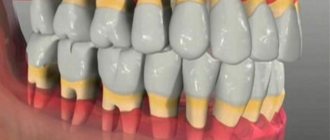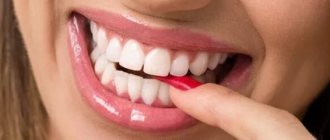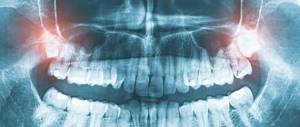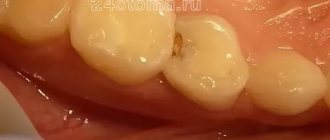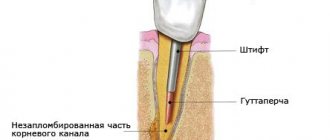Pain in the tooth root - what the symptom may be associated with and what treatment will help in such a situation
Toothache is considered one of the most severe - it literally pierces through, leaving no chance for a normal life. But even despite such an acute symptom, some persistently postpone a visit to the dentist, drowning out the unpleasant sensations with pharmaceutical painkillers or, even worse, with the thoughtless use of traditional medicine. Meanwhile, the pathological process penetrates deeper into the dental tissues, spreads to the nerve and roots, leading to even more serious and sometimes irreversible complications. Today we’ll talk not just about toothache, which usually appears with caries, but about what causes tooth root pain and what to do about it.
How to prevent the development of inflammation
Prevention of periodontal inflammation includes the following recommendations.
- Oral hygiene. Brushing your teeth twice a day and using dental floss will help regularly remove bacterial plaque and tartar deposits from the surface of your teeth and gums.
- Use of toothpastes with fluoride and fluoride compounds, the dosage of which should not exceed the norm (1.5 thousand ppm for adults and 1 thousand ppm for children under 12 years of age).
- Balanced diet. Dentists recommend minimizing the consumption of sugar, sucrose, as well as sugar-containing foods and drinks (especially carbonated sweets). At the same time, the table should have fresh vegetables, seasonal fruits, dairy products without preservatives, protein-rich foods and complex carbohydrates on the table every day.
- Regular removal of tartar at the dental clinic (as needed).
Remember that regular visits to the dentist every 6 months for a routine examination are the key to ensuring that your teeth will always be in excellent shape. As mentioned above, the main reasons leading to the appearance and development of apical periodontitis are untreated advanced forms of caries and pulpitis, and a timely visit to the doctor will help avoid unpleasant consequences.
Possible causes of pain
So, what can it mean if the root of the tooth hurts when you press on the gums or even without external mechanical irritants? In fact, there are quite a few potential causes, and among them there are both minor ones that are easy to fix and complex ones that require serious treatment.
Pulp ischemia
The pathology is associated with a lack of oxygen in the tissues that nourish the pulp, and this can also cause pain. The disease usually develops against the background of problems with blood vessels, injuries, infections in the body, disturbances in the endocrine system, oncological processes, contamination with toxins, and disruptions in the nervous system. Sometimes ischemia is a consequence of diseases of the hematopoietic organs or digestive system. And in this case, it usually becomes chronic with periodic exacerbations.
Pulpitis - inflammation of the nerve
Most often, the disease becomes a consequence of untreated caries, when pathological processes penetrate deeper into the tooth structure and lead to inflammation of the neurovascular bundle. The pain becomes almost unbearable. In such a situation, it is better to act quickly so that the inflammation does not spread to the periodontal tissues and lead to the development of periodontal disease. In the early stages, drug therapy may be effective, but more often it is necessary to completely remove the nerve and fill the canals.
Neoplasm in the form of granuloma
A pathological nodule in the thickness of the gum tissue is formed near the tooth root and most often becomes purulent in nature. The reason for this may be trauma, infection in the tooth or soft tissues, abnormal growth of the wisdom tooth, or medical errors made during endodontic treatment. Granuloma does not make itself felt immediately. It is better if it can be identified on an x-ray before the surrounding tissues become inflamed and the gradual filling of the cavity with purulent exudate does not lead to severe throbbing pain. Then the mucous membrane in the area of the causative tooth turns red and swells, the patient’s cheek swells, the temperature rises - the granuloma develops into a cyst.
Extensive cyst
A larger neoplasm in the thickness of the gums, the focus of which is usually localized at the very root and often represents an untreated granuloma. The neoplasm can lead to severe swelling of the mucous membrane and facial asymmetry. If the gum is swollen and there is a painful lump filled with pus on it, you need to urgently run to the doctor. Sometimes the removal of such neoplasms must be performed together with excision of part of the root system in order to completely eliminate the pathological focus - resection of the root apex is performed.
Exposed necks of teeth – gum recession
Gum recession is not an independent disease, but only a pathological condition. If the root of a tooth is exposed, this can be a symptom of a variety of conditions: gingivitis, periodontitis, periodontal disease, malocclusion, poor hygiene, trauma or excessive subgingival calculus. In such a situation, the root under the artificial crown may also hurt, and canal treatment and re-prosthetics will be required. If the pathology has become generalized, discomfort may spread to the entire upper or lower jaw.
The symptom itself requires differential diagnosis and an integrated approach to treatment. Thus, periodontitis and periodontal disease as its complication are diseases that cannot be cured completely. However, it is always possible to achieve stable remission, and here only comprehensive treatment will be effective, taking into account the stage and individual characteristics of the clinical picture.
Tooth root injury
If pain appears after a blow or bruise, you need to see a specialist as soon as possible. When the cause is a mechanical injury, an accurate prognosis can only be given based on the results of an X-ray examination. Until the doctor examines the broken tooth and sends it for an x-ray, it is better to try not to make sudden movements of the head and jaws.
What provokes the inflammatory process
Periodontium is the connective tissue located between the cementum of the tooth and the alveolar plate. Inflammation of this tissue that forms the tooth root is called periodontitis. There may be several factors that trigger the pathogenic process:
- The consequences of advanced caries and pulpitis are infectious inflammation of root tissue.
- Incorrect treatment of pulpitis causes drug-induced periodontitis. It occurs due to the contact of potent medications (for example, arsenic) on the surface of the periodontium. Sometimes the root becomes inflamed due to an allergy to medications used to treat pulpitis.
- Jaw injuries (from blows, falls, regular microtraumas). The course of traumatic periodontitis is quite acute.
- Inflammation of the root tissues of the tooth can be a complication after sinusitis, other ENT pathologies or osteomyelitis (an extra-dental type of disease).
In addition, the reasons that cause inflammation of the peri-root tissues of the tooth include the following pathologies: rupture of the wall or the entire root cavity; lack of patency of root canals; cystic formations around the tooth root or already grown into the maxillary sinus; injury to root tissues when removing pins or core inlays. In severe advanced stages, with inadequate therapy, marginal periodontitis can be observed, in which the gums are also affected along with the root apex.
Associated symptoms
Toothache itself is very severe - this is always a good reason to see a doctor as soon as possible. But usually this is not the only symptom, and with inflammation of the internal structures of the tooth, the general clinical picture has similar features: the pain intensifies with mechanical action, and becomes pulsating in nature if purulent processes occur.
The surrounding mucosa turns red and swells. Lymph nodes often become inflamed, the temperature rises and signs of general malaise appear. With periodontitis, that is, inflammation of the tissues surrounding the root, blood tests show an increased level of leukocytes and ESR. If the pathology has entered a chronic stage, the causative tooth may darken, and during periods of exacerbation, a lump with purulent contents will appear on the gum.
What treatment is carried out if the roots hurt?
If you experience pain in your teeth, you should first contact your dentist. Only after a visual examination and appropriate diagnostic procedures will the doctor be able to make an accurate verdict - make a diagnosis and prescribe the necessary treatment. One of the most common causes of this symptom is inflammation of the nerve or pulpitis. In such a situation, there are two treatment options at the discretion of the specialist:
- with nerve preservation: the tooth is opened and access to the nerve is provided. Medicine is applied to the pulp chamber, and a temporary filling is fixed on top. After some time, the patient will have to return to see the doctor for a refill or permanent filling,
- with depulpation, that is, with the removal of the pulp: the doctor opens the carious cavity, completely removes the neurovascular bundle, after which he cleanses and treats the root canals, filling them. If necessary, as in the case of periodontitis treatment, the specialist can place medicine in the canals and invite the patient to return after a while for the final installation of the filling. This method is more effective and less dangerous in terms of relapses1.
As for the nerve removal procedure itself, first you need to rinse the canals, and then place a devitalizing paste in the tooth (previously they used arsenic). Killing the nerve is a gradual process, requiring several days. At your follow-up appointment, the doctor will remove the product, treat the canals, seal them and place a permanent filling. Some people say that the root of a dead tooth hurts, but in reality it cannot bring them any sensation. If a tooth is without a nerve, but pain is present, this may indicate inflammatory and purulent processes in the periodontium.
If the cause of discomfort is inflammation of the root itself and the tissues surrounding it, as well as the appearance of pathological neoplasms nearby, in such cases surgical intervention is often required. Usually, the inflammatory focus is removed along with cutting off the root apex - its resection. The operation is performed after removing the nerve and filling the canals. Sometimes it is necessary to completely remove one of the roots along with the crown and additionally restore bone tissue with the help of osteo-replacement chips - when the inflammation has spread to the jawbone and led to its resorption. If the remaining part of the root becomes painful after some time, this will mean only one thing: the treatment was carried out insufficiently, resulting in a hidden pathological focus.
Inflammation of the bone tissue of the tooth
The inflammatory process is the primary source of osteitis in the bone tissue of the jaw; if proper treatment is not provided in time, it will develop into periostitis (the periosteum becomes inflamed), osteomyelitis (the bone marrow becomes inflamed). With osteitis, pain is felt, the affected area swells, difficulties arise in chewing food, and the entire jaw gradually begins to ache. The cause of symptoms of osteitis is:
- Received traumatic actions, blows, bruises, jaw fracture;
- Surgical complication;
- tuberculosis and syphilis;
Treatment of osteitis occurs through surgery with the use of antibiotics and immunostimulating medications. Decaying teeth harbor bacteria and must be removed to prevent further inflammation. Patients with tuberculosis or syphilis first cure the underlying disease, then proceed to eliminate osteitis.
The slightest suspicion of pain in the bone tissue in the oral cavity is a reason to consult a doctor. Treatment of osteitis started in the first stage will make it possible to save teeth and protect against painful complications. Successful treatment depends on correct implementation of the dentist’s recommendations and careful oral care.
Is it really necessary to pull teeth?
Many are so afraid of excruciating toothache that they prefer to get rid of the tooth forever, rather than treat it and leave, albeit insignificant, the risk of relapse. And it’s one thing if it is destroyed, when the crown has crumbled to the very root, and quite another thing if the tooth appears healthy in appearance. In the latter case, the doctor will definitely do everything possible to preserve the nerve. If this cannot be done, you will have to carry out depulpation, but this is not a reason to completely remove the roots.
Experts take such extreme measures in cases where there is no other way to ensure that the pathological focus is eliminated or the root is severely affected. But even in this case, pain can occur after removal if the inflammation has spread to nearby tissues or the infection has not been completely eliminated. In any case, it is better to leave this issue at the discretion of the attending physician - an experienced specialist will be able to correctly assess the clinical picture from X-ray images and choose the correct treatment tactics.
How to reduce pain - home remedies
Traditional medicine is good only in moderation and only after consultation with a specialist. Independent attempts to relieve pain using medicinal herbs can lead to even more serious complications or the development of an allergic reaction. Below are popular folk tips that you need to apply wisely:
- soda-salt solution: mix baking soda and salt in equal proportions and add warm water - a teaspoon per glass. Use the solution for rinsing until the condition eases,
- propolis: the product has a powerful anti-inflammatory effect. A piece of pure propolis can be applied to a sore spot. Alternatively, you can rinse your mouth with the prepared tincture,
- compress with honey and cinnamon: mix a teaspoon of honey with a crushed cinnamon stick. Apply the resulting mixture to the gum and hold for a while.
These tips will help to somewhat muffle the acute symptoms, so they are recommended as maintenance therapy, but not the main treatment. Attempts to cure the disease on your own will not lead to anything good - if they do not provoke complications, then they will allow the pathological process to develop into an advanced stage, and then you will have to say goodbye to the tooth.

